
Jaurès is a station on Paris Métro line 2, line 5, and line 7bis in the 10th and 19th arrondissements.

Vavin is a station of the Paris Métro on line 4 on the border of the 6th arrondissement and 14th arrondissement, under Place Pablo-Picasso at the intersection of Boulevard du Montparnasse and Boulevard Raspail. It is named after the nearby rue Vavin, named after 19th-century statesman Alexis Vavin (1792-1863).
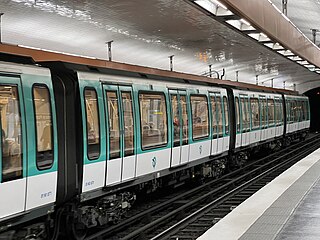
Église de Pantin is a station of the Paris Métro, serving line 5. It is named after the nearby Église Saint-Germain de Pantin, a local church.

Hoche is a station of the Paris Métro, serving line 5. It is named after the nearby rue Hoche, which in turn was named after Lazare Hoche (1768-1797), a general during the French Revolution who at the age of 25, commanded the Army of the Moselle in which he drove the Austrians back to Wœrth, cleared Landau and Alsace. The platform in the direction of Bobigny contains in a display case where a bust of Lazare Hoche as well as several images evoking his life as a general were installed.

Porte de Pantin is a station of the Paris Métro, serving line 5. It is named after the nearby avenue de la Porte de Pantin, on the edge of Paris leading to the town of Pantin. It was in turn named after the nearby Porte de Pantin, one of the former gates of Paris. The station's name has been subtitled Parc de la Villette since the creation of the eponymous park in 1987 on the site of the former slaughterhouses of La Villette to the north of the station which closed in 1974.

Laumière is a station of the Paris Métro on line 5 in the 19th arrondissement. It is named after the nearby avenue de Laumière, which was in turn named after Xavier Jean-Marie Clément Vernhet de Laumière (1812-1863), a general killed during the French intervention in Mexico in the 19th century.

La Motte-Picquet–Grenelle is a station of the Paris Métro, at the interconnection of line 6, line 8, and line 10 in the 15th arrondissement. The station combines underground and elevated platforms. It is a major métro interchange on the Rive Gauche, the biggest west of Montparnasse.

Montgallet is a station on line 8 of the Paris Métro in the 12th arrondissement. It is named after the nearby rue Montgallet, which is in turn named after the former owner of the land on which the road was built upon. Rue Montgallet is well known in Paris for its computer shops.

Michel Bizot is a station on line 8 of the Paris Métro in the 12th arrondissement. It is named after the nearby avenue du Général-Michel-Bizot, which is in turn named after the French military engineer General Michel Brice Bizot (1795–1855), fatally shot at the siege of Sevastopol during the Crimean War.

Porte Dorée is a station on line 8 of the Paris Métro in the 12th arrondissement.

Liberté is a station on line 8 of the Paris Métro in the commune of Charenton-le-Pont. It is named after the nearby avenue de la Liberté which runs above the station, it refers to the motto of the France: Liberté, égalité, fraternité.

Billancourt is a station of the Paris Métro, located in the commune of Boulogne-Billancourt. It is named after the nearby rue de Billancourt, which was in turn named after the former village of Billancourt which was annexed in 1859 into the commune of Boulogne-Billancourt.

Marcel Sembat is a station of the Paris Métro. It is named after the nearby place Marcel Sembat which was named after the journalist Marcel Sembat (1862–1922) who was a director of the socialist review LaPetite République from 1892 to 1897 and husband of the painter Georgette Agutte from 1897 until their deaths in 1922. He was also the Minister of Public Works from 1914 to 1916 as well as socialist deputy for the 18th arrondissement of Paris's Grandes-Carrières district from 1893 till his death in 1922.

Porte de Saint-Cloud is a station of Line 9 the Paris Métro. The station is named after the Porte de Saint-Cloud, a gate in the nineteenth century Thiers Wall of Paris, which led to the town of Saint-Cloud. It serves the Parc des Princes, a stadium and home of the Paris Saint-Germain F.C.
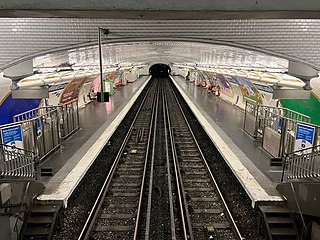
Ranelagh is a station on line 9 of the Paris Métro located in the 16th arrondissement.

Croix de Chavaux is a station on line 9 of the Paris Métro, at the crossroads called Croix de Chavaux. The "chavaux" in the name of the crossroads is probably a corruption of the French "chevaux" ("horses"). The "croix" may be a reference to the crossroads or to a wayside cross.

Mirabeau is a rapid transit station on Line 10 of the Paris Métro system. Located in the 16th arrondissement of the city, it is served solely by eastbound trains to Gare d'Austerlitz. It is located in close proximity to Église d'Auteuil, and as such, the two stations can be considered twins, with Mirabeau serving eastbound traffic and Église d'Auteuil serving westbound traffic, albeit with separate entrances and exits. The station is named after the nearby rue Mirabeau, under which it runs. It was in turn named after Honoré Gabriel Riqueti, the Count of Mirabeau, a leader during the early stages of the French Revolution. The station is near the Pont Mirabeau.
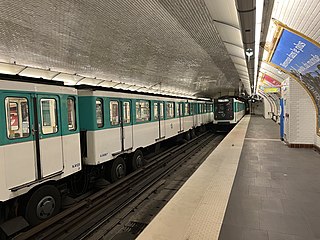
Mairie des Lilas is a station of the Paris Métro in the commune of Les Lilas and was formerly the eastern terminus of Line 11. It is named after the town hall of Les Lilas. A small underground depot is located near the station to service the trains of Line 11. The station is sometimes believed to be the subject of the Serge Gainsbourg song "Le Poinçonneur des Lilas", about a Métro ticket inspector, although the promotional film for it was filmed at the Porte des Lilas.
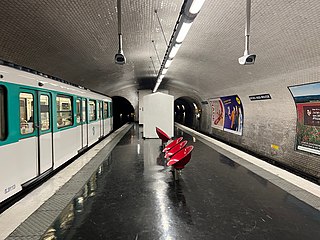
Michel-Ange–Molitor is a station of the Paris Métro in the 16th arrondissement, serving as an interchange between Line 9 and Line 10. It is named after the nearby rue Michel-Ange, which was in turn named after Michelangelo as well as the nearby rue Molitor, which was named after Count Gabriel-Jean-Joseph Molitor (1770–1849), a Marshal of France.
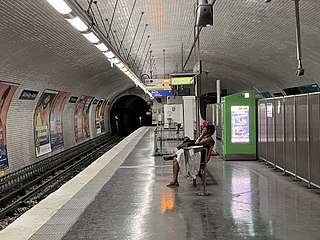
Michel-Ange–Auteuil is a station of the Paris Métro in the 16th arrondissement, serving as an interchange between line 9 and line 10. It is named after the nearby rue Michel-Ange, which was in turn named after Michelangelo as well as the nearby rue Auteuil, which was named after the former village of Auteuil. The Embassy of the Central African Republic is located nearby.
























